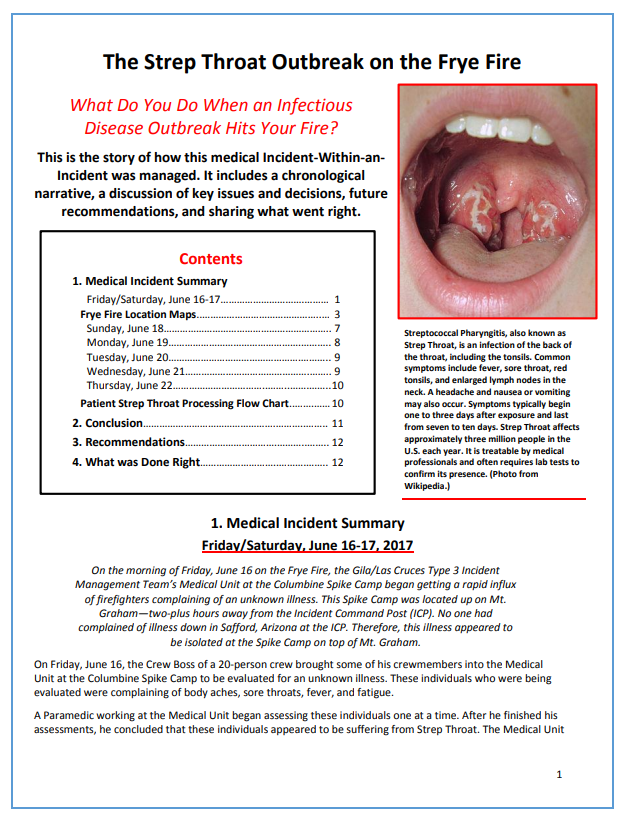With our current coronavirus crisis throwing new, uncharted curve balls at the wildland fire service today, it might be a good time to revisit the “Strep Throat Outbreak on the Frye Fire” June 2017 Incident-Within-an-Incident report that documents this medical dilemma and response: https://www.wildfirelessons.net/viewdocument/frye-fire-strep-throat-outbreak-20.
Make no mistake, we are not comparing the current COVID-19 pandemic to Strep Throat.
But we are saying that the precautions, actions and decision-making—the lessons and recommendations— from this fire and its quarantine of firefighters just might be helpful for us to consider at this point in time in 2020.
 Here’s some examples of the content/information from this report:
Here’s some examples of the content/information from this report:
The aggressiveness of this particular outbreak—and with nearly 300 firefighters potentially exposed—was considered a risk to the local communities. Therefore, important measures were taken to also limit the public’s exposure to the illness.
Protocols and Procedures
Protocols and procedures were developed, put into place, and recommended at all briefings. They included: less interpersonal contact (less hand shaking), being vigilant in the use of hand washing and the hand sanitizer, and to be on the lookout for any new Strep Throat cases that might appear.
In consulting with the doctors and the County Health Department, it was decided that people who tested positive for Strep Throat would be placed in an initial isolation of 24 hours (the time for the antibiotics to render the bacteria to a non-contagious state), plus an additional 24 hours for rehabilitation to be sure any other symptoms could be remedied.
Aggressive—Successful—Approach
The Gila/Las Cruces Type 3 IMT undertook a progressive approach. Due to the aggressiveness of this Strep Throat outbreak and the possibility that nearly 300 people had been exposed, the Type 3 IMT recommended that no more crews or persons should leave the Spike Camp at the top of Mt. Graham, thus lessening exposure to even more people. The Type 3 IMT also attempted to isolate those persons complaining of symptoms. In addition, aggressive sanitary practices were initiated at the Spike Camp to try to halt the spread of Strep.
Strep can be spread directly (person to person) and indirectly through food and water. Therefore, the Type 3 IMT also had water sources tested multiple times. At morning briefings at Spike Camp, the Medical Unit informed all personnel to: 1) wipe down all their gear, equipment, and vehicles with Clorox disinfecting wipes or use hand sanitizer and a towel; 2) wash hands frequently and to apply hand sanitizer often; and 3) avoid personal contact whenever possible.
The medical personnel broke into teams of two and proceeded to wipe down everything in Spike Camp with Clorox disinfecting wipes.
The Medical Unit Trainee met with the Base Camp Manager to ensure that all cubies were dumped and that all water spigots were flagged for “No Use.” The Medical Unit Trainee also met with the Shower Unit personnel to inform them of the situation and asked them to thoroughly clean all of their equipment. He also asked them what type of cleaner they used to clean the showers and wash sinks. They informed that they use a hospital-grade cleaner and sanitizer. The Shower Unit personnel were kind enough to provide the Medical Unit with this product to assist in their spread-prevention efforts.
First 24-36 Hours of Strep Outbreak’s Discovery had Competing Issues to be Addressed
Ironically, during this disease outbreak’s first 24-36 hours of discovery—when it was unclear why and how so many firefighters at the remote Spike Camp up on Mt. Graham (more than a two-hour drive from the ICP in Safford) were becoming ill, two other key factors were also occurring:
- The fire was transitioning from the Type 3 IMT to the Type 2 IMT.
- The fire was exhibiting challenging growth and suppression complexity.
Both the outgoing and incoming Incident Commanders were in constant contact. They attempted to make the best, educated safety-conscious decisions concerning caring for the sick firefighters while also fighting a very complex, growing fire.
The fact that radio and cell phone communications were problematic in the area where the Spike Camp was located helped to compound the initial perceived chaos surrounding this unfolding medical event.
Maintaining communications between camps (ICP and spikes) during crisis events was a key point brought forward in Section 4 “Recommendations.”
34 Individuals Test Positive for Strep Throat
Dr. Batty took Rapid Strep Swab Kits and antibiotics up to the Spike Camp. (Using the Rapid Strep Swab Kits, the throat and tonsils are swabbed to collect bacteria from the infected area for testing.) Dr. Batty initially swabbed more than 80 firefighters. That first night, he diagnosed 34 individuals as testing positive for Strep Throat and immediately began treating them with the antibiotic Azithromycin.
Directives were given to ensure that:
- This bacterial infection outbreak was contained;
- Firefighters were treated and isolated as necessary to minimize/stop the Strep Throat spread;
- Immediate contact be initiated with the Graham County Health Department and subsequently the State Health Department and whomever else was needed to investigate the outbreak.
-
Page 12 of the “Strep Throat Outbreak on the Frye Fire” report lists eight bullets under “Recommendations” and six bullets under “What was Done Right”.
Check it out!
Conclusion
Once again, it’s important to acknowledge and emphasize that the Frye Fire’s response to a Strep Throat outbreak and quarantine experience is not offered here in this blog post as a solution to the current coronavirus pandemic. Rather, it is hoped that learning about this prior medical incident that occurred in 2017 will help us to imagine the realities that we could soon face in 2020.
There is are aspects of strep infection that are relevant and they stem from a systemic infection and the heart damage associated with high fever and systemic strep.
LikeLike
I sincerely hope that extra precautions will be taken in fire camp this season
LikeLike